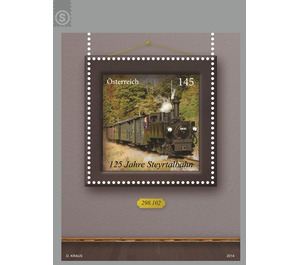125 years Steyrtalbahn - Austria / II. Republic of Austria 2014
Theme: Traffic, Transportation & Mobility
| Country | Austria / II. Republic of Austria |
| Issue Date | 2014 |
| Edition Issued | 150,000 |
| Item Type | Block |
| Chronological Chapter | OOS-OE2 |
| Chronological Issue Number | Block 82 |
| SID | 956473 |
| In 28 Wishlists | |
Austria's oldest narrow-gauge railway along the Steyr runs through untouched landscapes at 760 millimeters gauge and transports its guests to another era - this year the Steyr Valley Railway, now a museum railway, celebrates its 125th birthday and is honored with a special stamp from Austrian Post. In 1887, Josef Ritter von Wenusch received the order to build a narrow gauge line from Steyr to Grünburg, and on 22 August 1888 the groundbreaking ceremony took place. Nearly a year later, on 19 August 1889, this first section was solemnly opened. In November 1890, the route was extended to Agonitz, 1891, the branch line from Pergern to Bad Hall was put into operation. The following years were marked by financial difficulties, floods and the competing behavior of the Kremstalbahn - in 1909, however, the last section was opened to Klaus, and the Steyr Valley Railway reached its longest route. Finally, the financial success began to adjust, especially at the beginning of the war, the narrow-gauge railway was able to achieve good profits by transports for weapons factories. After the end of the First World War, however, it came mainly by the onset of bus traffic to the burglary - 1931, the operation of the Steyrtalbahn AG was nationalized with the takeover by the BBÖ, in August 1933 was the closure of the line Sierning - Bad Hall. After the Second World War, the Steyr Valley Railway remained in state hands; Since the superstructure of the railway was too light for the new diesel locomotives, she also remained the steam locomotives. In the mid-1960s, the narrow-gauge railway again came in red, the gradual decommissioning and removal of the track was unstoppable. On March 14, 1980, an early train drove on his way from Leonstein to Haunoldmühle in a rockfall, which eventually gave rise to the task of the last leg. The official setting of the Steyr Valley Railway took place on 1.12.1982. However, the Austrian Society for Railway History (ÖGEG) saved the Steyrtalbahn from being completely wiped out - it was able to maintain the first section from Steyr to Grünburg as well as some of the locomotives and wagons and run it as a museum railway. The continuation of the historical narrow-gauge train is made possible by the dedicated and exclusively honorary activity of all employees. Today, the Steyr Valley Railway steams for 17 kilometers through one of the most beautiful valleys in the region and promises a nostalgic and romantic outing for the summer as well as the advent season. The motive of the special stamp block "125 years Steyrtalbahn" shows the steam locomotive with the number 298.102, with the year of construction 1888 the oldest remaining Austrian 760 mm narrow gauge locomotive.


